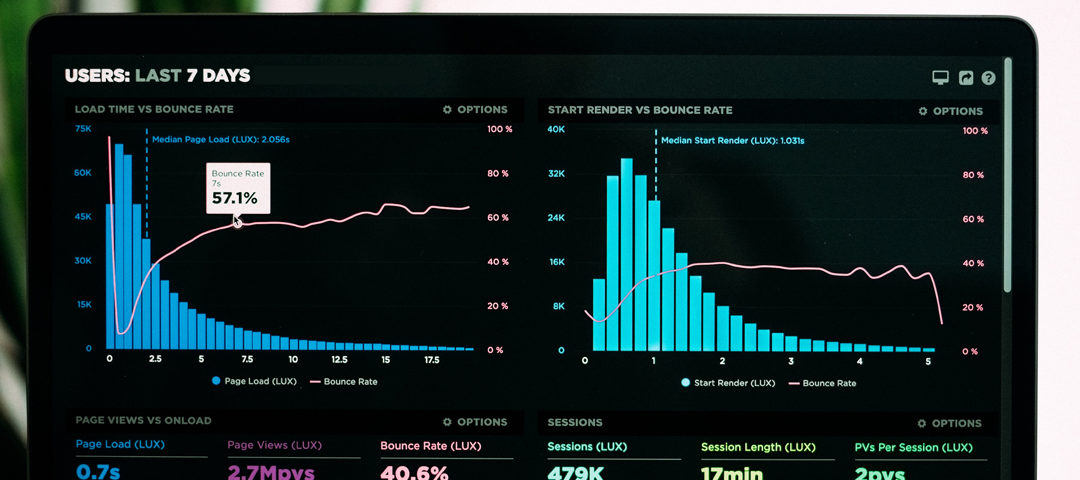No Results Found
The page you requested could not be found. Try refining your search, or use the navigation above to locate the post.


Your website is still a critical touch point in your sales process, giving you the opportunity to connect with potential customers and demonstrate your ability to deliver an amazing service. Maintaining a website that connects with and converts leads is crucial to growing your business.
After building and maintaining hundreds of small business websites, we’ve seen several patterns emerge. These five common problems that can negatively affect your website’s performance. The good news is that these challenges are easy to solve with a little time and the right resources.
83% of mobile users say that a seamless experience across all devices is very important and yet only 17% of websites are considered mobile friendly by Google.
When building your website, take into consideration all screen sizes and build it according to the latest responsive design standards. Now more than ever, people are accessing websites from their mobile devices. Today’s tech tools make it easy to build beautiful looking mobile websites that result in positive interactions with your brand.
How to Fix It: Invest in mobile responsive design so your customers have the best experience on your website on their devices.
Conversions require a relevant call to action (CTA) that’s easily visible. A call to action moves a customer closer to working with you. Potential customers won’t be inclined to take the next step if it’s unclear what they should do next.
Is the first step in your buyer’s journey educational? Perhaps they should download a free guide or review product specs.
Is your product highly customizable for the unique needs of each client? Perhaps you want to highlight case studies that demonstrate your ability to partner with customers and solve complex problems.
The customer journey is different for every business. It’s your job to test and understand what moves them closer to becoming a customer with the right CTAs placed strategically around your website.
How to Fix It: Make it clear and obvious what you want the website visitor to do. Include several different types of CTAs throughout your site. Measure and track your progress to see what performs the best.
Optimizing for Google strengthens consumer trust and value. When a business ranks high in organic search results, it generates a certain level of trust, respect and credibility which are necessary for brands relying on digital channels for leads.
Visibility on the internet involves technical and creative and strategies to encourage traffic, leads and sales – but optimization isn’t one and done. It’s an ongoing task. While the frequency of these updates will be determined by the competitiveness of your specific niche/keywords, you must make this a priority.
How to Fix It: Make sure you periodically update on-page elements like title tags and meta descriptions. Keep the content (blogs and case studies) and imagery updated as well.
As many small and mid-size businesses discover, managing and maintaining a website can be especially challenging if you don’t partner the right professional. Front-end content updates are essential to demonstrate your expertise. And technical support ensures your site remains up and running.
Without the proper support, many websites are left for dead. Your website should do more than simply exist! It’s a tool that can communicate valuable information about your business and your services. It’s easy to spot a website that hasn’t been touched: the graphics begin to look dated, blog content is old and the mobile experience is less than ideal.
How to Fix It: If you’re unable to hire an in-house professional, it’s best to outsource this work to a trusted partner, freeing up your internal team to focus on what they do best.
Do the visitors of your website leave after just checking out a few articles or pages?
Do they spend significant amounts of time surfing your website?
A little more than half of all website visitors spend less than 15 seconds on any given website, and we obviously want these visitors to hang around longer than that.
Publishing original content such as blog articles, case studies, podcasts, videos or white papers gives visitors a reason to explore your website. As you build trust and credibility, your website becomes a more powerful sales tool for you. Search engines continue to reward new content, so keep this in mind if your goal is to attract more organic traffic.
How to Fix It: Develop a content strategy to position your SMB as a thought-leader. Commit to something manageable, even if it’s one new piece of content per month.
Remember that a website is always in development. The time and energy you spent on your current website was not wasted – it’s a great place to start. Now is the time to update your site so it converts leads and grows your business.
Hopefully the tips above will help improve website conversions. Have more questions about improving your website? Reach out to us directly.
Editor’s Note: This article was last updated in April 2021.
The page you requested could not be found. Try refining your search, or use the navigation above to locate the post.
What makes marketing so challenging?
Trying to keep-up with the tools, technology and the limited attention span of your target market are all challenging. Get our tips on how to grow leads and revenue, delivered directly to your inbox.


A well-rounded digital marketing strategy includes many elements. From paid ads to organic search engine marketing, your brand needs to be present and visible on numerous channels. However, there is an underlying component that fuels it all: content.
Content is arguably the most important component of your digital marketing and your website. It can set you apart from the masses by demonstrating your knowledge, expertise and capabilities. Other elements such as design, photography and video are important, but it’s the content that will speak directly to the customer’s needs and wants.
Content is also present in every step of the sales funnel. When your audience is looking for a solution to their problem, they seek professional insight in the form of blog articles, checklists or white papers. When your audience is closer to making a purchase, they will further explore your services, case studies or testimonials.
The bottom line is that along with having a great design for your website, it’s also vital that the information you’re providing is high-quality, relevant, and can convert visitors into qualified leads.
What is quality content and how can it be incorporated into your website? It can take many forms but there are several elements that all high-quality content contains.
It Provides Value: Your audience wants a solution to their problem. To craft high-quality content, it’s necessary to understand exactly what your audience needs and wants. When you understand their pain points and goals, you can write content that directly addresses them.
It Has a Long Lifespan: The term “evergreen content” refers to content that remains useful for many months or even years after its initial publish date. It can be shared many times over or repurposed into different formats like video and podcasts.
It Fuels Your Digital Strategy: As mentioned, content is the foundation for most digital marketing strategies. From email marketing to social media to PPC ads, you can attract and engage your ideal audience with the right content.
It Moves Your Audience Through the Sales Funnel: Great content can help you build relationships with an audience and inspire them to take action. Think about and craft content that is not only informational, but also inspiring, motivational and directs the reader to next steps.
Actively maintaining the content on your website can be a significant undertaking. Everything ranging from blog articles to service pages need periodic updates. Unfortunately, many SMBs have an outdated website. A website should never be stagnant. An untouched site creates a disconnect for your audience and potentially harms the brand you’ve spent time building.
Publishing new content or updating existing content is well worth the investment. If it’s done correctly, you’ll see an improvement in your search rankings and improved engagement on your site. Here are several suggestions to ensure your content conveys the right message:
Update Older Pages and Articles
Posts and pages published years ago need periodic updates to ensure they remain evergreen. Updating statistics, timelines and major milestones ensures that you maintain your authority and trustworthiness as a source. Updating your pages/posts will also signal to search engines that a page is still relevant to searchers.
Revamp Your Keyword Strategy
Search intent and keyword trends are always changing. You should continually reassess your keyword strategy when updating your content. You might have pages ranking for keywords that no longer generate the search volume they once did. This could be an opportunity to refresh the content and target new keywords.
Create a Website Content Calendar
A documented content schedule will help you stay consistent with your updates. It can keep you focused on the content that’s relevant to your audience. You can also keep track of when pages and articles were last updated, or make note of new content ideas.
Hopefully the tips above will help improve your website content. Have more questions about running successful marketing campaigns? Reach out to us directly.
Editor’s Note: This article was last updated in June 2021.
Automated emails are one of the best methods to nurture leads and convert them into paying customers. When you have an effective email campaign that provides significant amounts of value to those who follow your content, your organization can generate revenue with minimal ongoing effort.
As the world becomes more and more digital in its communication, marketing campaigns utilize a set of metrics that are much more trackable and manageable than they ever were.
Having a strong website is important because it’s often the first impression you will make on potential customers. Whether they found you through a search engine or through a link shared by a connection, your website is typically the first point of contact.
What makes marketing so challenging?
Trying to keep-up with the tools, technology and the limited attention span of your target market are all challenging. Get our tips on how to grow leads and revenue, delivered directly to your inbox.

Don’t waste time on meaningless metrics. Learn how your company can measure goals and track performance with these KPIs.

Marketing metrics are more accessible than they have ever been, taking most of the guesswork out of how well your campaigns performed. But it can also be very easy to lose yourself in the amount of data that you encounter.
Mastering digital marketing has changed. It used to be about discovering certain marketing metrics that could be measured. Now it is about focusing on the metrics that matter the most.
Of the dozens of marketing metrics that you can track, there are seven that not only matter tremendously but also fall in line with the inbound marketing approach that we follow. The goal of inbound marketing is to generate more leads through your website which can place you in control of the sales cycle, allowing you to pursue stronger partnerships with potential clients.
Once you have a good handle on these seven metrics, your organization will run more effective campaigns. You’ll find that your internet visibility is stronger, and your expertise is in much higher demand.
Here are seven marketing metrics that you should be tracking and improving.
Visits to your website is a very simple metric to track, and often the most important. Traffic is one of the best indicators of not only how effective your message is, but also how responsive your target market is.
In fact, a lot of the metrics we’ll be exploring revolves around traffic. Website traffic can be grouped into four main groups: Direct, Organic, Referral and Paid.
Direct Traffic
These are visits that come from anyone who directly enters in the URL of your website or social page into a browser.
Direct traffic is also generated by those who click on a bookmark or a link that was put into an email, a comment, or in a chat room.
Organic (Search) Traffic
This kind of traffic typically comes from search results that are not the result of a paid ad. Organic traffic is a direct result of the search engine optimization efforts of the content on your website or social media page.
Referral Traffic
Referral traffic is traffic that comes from third party websites. Like organic and direct traffic, referral traffic is not the result of a paid ad. Instead, it is the result of links from press releases, guest posts, business directories, or other social media pages.
Paid Traffic
When someone arrives at your website by way of an advertisement, it is known as paid traffic. In order to get the most out of paid traffic, you’ll want to set up proper analytics software so that this particular kind of traffic is tracked the right way.
All four forms of traffic should be tracked regularly, but the two kinds that you should prioritize the most are organic traffic and direct traffic since they are strong indicators of credibility with search enginges and existing clients.
Pro Tip: Use your existing data in Google Analytics to create a baseline. Understanding your baseline is critical to developing an effective marketing strategy.
Ready to take action? Let’s have a conversation.
Tracking how much time visitors spend on your website is just as important as monitoring the kinds of traffic your website gets.
In fact, time spent on a website can tell you the story of how effective any given marketing campaign truly is.
Take paid advertising, for example. If visitors to your website navigate away from it seconds after clicking on the advertisement, what does that say about your paid advertising campaign?
Increasing the visitors spend on your website or social media pages begins with making sure your strategy focuses on the pain points of any given buyer as well as content that addresses any challenges they may have.
Speaking of content, original content that has high value will not only get visitors to stay on a website for longer, it will also demonstrate to search engines how relevant your website is in any given industry.
When somebody has visited your website and navigates away from it without any kind of interaction, such as following a different link on your website or adding something to the shopping cart, they have “bounced” from your website.
Like with time spent on a website, this bounce rate will determine not only how effective your marketing campaigns are, but it will also determine how much value the content on your website provides.
If this rate is anything higher than 60%, you’ll probably need to make some serious adjustments to how your website looks, the message it is trying to send, and perhaps some of your CTA dialogue.
One of the most effective ways to reduce bounce rates is to align the content of your campaigns with your landing pages, as well as addressing one or two major pain points of those who visit your website. This will not happen overnight and you are only going to see noticeable results if you make systematic adjustments to this over time.
Overall website success will always be related to search rankings. The number of pages you rank for will represent the number of opportunities for your potential customers to discover your website.
Ideally, you want all the different pages you have on your site to rank high. Google Search Console is a free tool that can track this for you in a general way, or you can upgrade to a paid tool if you want even better insight. Some of the paid tools also show you how your competitors are ranking.
It is a common misconception that all visitors to a website is a lead that has been generated. This is not accurate at all. When someone visits your website, they are a potential lead.
Leads can only be generated by a CTA, or a call to action. Specifically, a website visitor needs to follow through on your CTA by entering some information in order to truly be a lead.
Determining the leads that have been generated per CTA in your content is one of the most useful of these marketing metrics, if not the most useful.
Like micromanaging your bounce rate, optimizing these leads to where you generate perfectly qualified leads does not happen overnight and will take time. Testing different CTAs is the best way to optimize leads.
Just like you need to know how many leads your CTAs are generating, you also need to know how many visitors to your website complete a desired goal out of the total number of visitors. This is known as a conversion rate.
A high conversion rate is ideal. Traffic doesn’t mean much if it doesn’t convert into leads who could possibly benefit from your services.
You can think of a conversion rate as a journey that a buyer takes that leads them to pursuing the products or services on your website.
There are three general phases that involve a different conversion rate for each. They are:
Just like there is a conversion rate for these three, there is also an opposing bounce rate for these. You will want to measure these against each other. Only then can you alter strategies and campaigns to improve conversions.
Probably one of the most important metrics to measure is ROI because it shows you how effective your campaigns are.
ROI is best expressed in a percentage. For example, a $1000 investment that generated $1200 in revenue would have an ROI of 20% since 1200 is 20% greater than 1000.
Determine your target ROI during planning and strategy conversions. Then work backward to further define the resources required to achieve this goal. Consider all of the resources you have at your disposal when doing this with the understanding that successful marketing campaigns take time it achieve your targeted ROI.
Digital marketing strategies are a marathon, not a sprint.
This is why you should keep a close eye on these metrics and make adjustments as you go along. The same principles of traditional marketing apply to web-based marketing campaigns. You need to build trust and authority with your digital audience, using these metrics as indicators of your progress.
Hopefully the tips above will help improve website conversions. Have more questions about running successful marketing campaigns? Reach out to us directly.
Editor’s Note: This article was updated in September 2021
Automated emails are one of the best methods to nurture leads and convert them into paying customers. When you have an effective email campaign that provides significant amounts of value to those who follow your content, your organization can generate revenue with minimal ongoing effort.
As the world becomes more and more digital in its communication, marketing campaigns utilize a set of metrics that are much more trackable and manageable than they ever were.
Having a strong website is important because it’s often the first impression you will make on potential customers. Whether they found you through a search engine or through a link shared by a connection, your website is typically the first point of contact.
What makes marketing so challenging?
Trying to keep-up with the tools, technology and the limited attention span of your target market are all challenging. Get our tips on how to grow leads and revenue, delivered directly to your inbox.

Is your inbox feeling a little crowded? I know many entrepreneurs feel this way so they decide that emailing their subscribers less frequently (or not at all) is the best course of action.

It can happen to even the most experienced marketing professionals. Your carefully-planned campaign didn’t perform as you had hoped – or worse, it was a total flop. All the time and effort you put into your initiative seems to have been in vain. Was the timing off? Was the message incorrect?

Digital marketing is one of the most effective ways for companies to market their services, generate leads and grow sales. But it can also present challenges to entrepreneurs and businesses due to the ever-changing nature of search engines and other websites.


Marketing campaigns that are precise and highly targeted yield the best results. But how can you generate results if you don’t know who to target? No matter what you’re selling, you’re always selling to people, which is why every company benefits from the creation of at least one client persona.
Client personas (or buyer personas) are the foundation of your marketing efforts. Without them, you won’t know what to say or what platforms to leverage. Client personas can drive real results for your brand when they are carefully crafted and used consistently.
A client persona is a semi-fictional, written representation of your ideal customer. It’s not meant to detail one specific person but is reflective of the group of people it represents. These descriptions are typically developed from customer insights and market research.
Because many organizations have more than one ideal customer, it’s common to group buyers into categories and develop several personas.
Creating and using your personas helps ensure you implement successful, laser-focused marketing campaigns. The “one-size-fits-all” approach rarely works. And you’ll waste a lot of time and resources in the process. Building a campaign with detailed personas ensures the right people are seeing your message which means you are more likely to convert qualified leads.
Here are a few additional benefits:
It is important to include as much details as possible. Each client persona should include details such as:
Ultimately, the goal is to create client personas for each of your main target markets so that it will be easier for you to understand their needs. This approach simplifies the marketing process because you can speak directly to each persona by utilizing your knowledge of the things that are most important to them.
Pro Tip: While your personas should be developed from data and customer insights, sometimes you’ll make edcucated guesses based on what you know.
My advice: start with your existing clients. Take a long, hard look at the people you already do business with. Even among a diverse group of clients, you’ll probably start to recognize similarities that can be used to describe your market.
A client persona doesn’t have to be perfect the first time. If it brings clarity and focus to your marketing, then it’s working.
You need to consistently reference each client persona to ensure your marketing campaigns communicate the right message and leverage the right tools – by tools I mean blogs, videos, news releases, social posts, etc. Consider that campaigns targeting a millennial customer will be very different from those aimed at their baby boomer parents.
Following this framework will allow you to get the most of your marketing budget and ensure that you achieve measurable results. And remember, you will revise your personas as you collect more information about your best clients and as your company evolves.
Have more questions about client personas? Reach out to us directly.
Editor’s Note: This article was last updated in August 2021.
Internet visibility drives website traffic and can help you reach your business goals. To get the most out of any SEO agency, you need to ask the right questions to ensure you find the right partner.
Competing in today’s business environment demands agility from marketing teams The pace of change requires marketing teams to stay agile The last several years have been dynamic and disruptive for manufacturers, forcing many to embrace more digital marketing...
As supply chain issues create out-of-stock scenarios across industries, brands are missing the opportunity to better align their marketing, sales and supply chain leaders. Learn how internal teams can work together during this crisis.
What makes marketing so challenging?
Trying to keep-up with the tools, technology and the limited attention span of your target market are all challenging. Get our tips on how to grow leads and revenue, delivered directly to your inbox.


Search engine optimization (SEO) is a complex, ever-changing subset of digital marketing that continues to grow in importance. The methods for improving a website’s visibility on search engine results pages (SERPs) range from technical to creative, and they work in tandem to create a positive site experience and encourage repeat visits.
While successful SEO requires extensive knowledge of how search engines work, there are several basic concepts that every CMO or VP of Marketing should understand to quickly evaluate their current situation and understand where there’s room for improvement.
This is the technical side of SEO and much of what we’re talking about in this category occurs “behind the scenes” on a website. But make no mistake, coding for SEO is vital. This is by no means an all-encompassing list, but these are definitely items you want to pay attention to.
Search Engine-Friendly URLs: URLs should be easily understood by humans and search engines. Keep things clean and nest pages in a manner that makes sense.
Meta Data: Basic meta data includes titles, descriptions and links. These elements should include relevant keywords but be mindful not to go overboard.
Redirects: Search engines don’t like duplicate content. You can use several different types of redirects to tell them which pages to look at.
Page Speed: Page speed is a ranking factor and the faster the better. Website visitors have little patience for a page that takes forever to load. Optimize code by removing unnecessary characters.
Cross-Device Compatibility: This refers to mobile-friendly websites which are now a priority for Google and their “mobile first” mindset.
Properly Tagged Images: Properly tagging images helps when an image fails to load for any reason. The user will see what the image is supposed to be with what’s known as “alt text.”
XML Sitemap: This is different from a user-facing sitemap. The XML sitemap is specifically for Google and helps identify the most essential website pages.
Content is still one of the best ways to show search engines that your site is relevant for a given topic.
Do you regularly publish helpful articles? Do you write content that your target market is actively searching for?
Original content typically includes blog articles, case studies, podcasts, videos or white papers. When you create thought-leadership style content for a specific topic, you demonstrate to search engines why your website is relevant. Here are a few tips to consider:
Experiment With Long-Form Content: These articles can be 1,500+ words in length.
Repurpose Old Content: Rather than reinvent the wheel, update an older article to reflect any recent industry changes.
Publish Transcripts: Video and podcasts are very popular, and the transcripts are a great way to add additional content to your site.
While some SEO professionals are placing less emphasis on keywords, we still believe they matter. Optimizing a website inherently involves keywords and keyword research.
Use a Reputable Tool for Research: Moz Pro and SEM Rush are two of our favorite tools.
One Word or Phrase Per Page: Avoid watering down SEO efforts. Remain focused by optimizing each page for one word or phrase.
Don’t go Overboard: Use the keyword a few times, ideally in the meta data and sprinkled throughout the content.
If you follow the best practices with website code and content, you’ll be well on your way to providing a positive user experience (UX) for site visitors. But it’s worth calling out UX as a separate objective because this goes beyond the technical components of a site.
UX involves thinking through every touchpoint that makes up the overall experience on a website. Graphic design is part of this, but at its core, UX involves understanding the user’s needs and objectives and creating a site that solves problems. Some initial questions to consider include:
Although links have become less important over the last few years, they still hold value. The easiest links to secure are typically directory listings. The most worthwhile directory listings are ones that relate to your industry niche. We suggest Moz Local as a place to start. Then explore industry specific directories like Avvo for attorneys or HomeAdvisor for contractors.
Have more questions about how to use search engine optimization to improve visibility? Contact us today for more information.
Editor’s Note: This article was last updated in March 2021.
Automated emails are one of the best methods to nurture leads and convert them into paying customers. When you have an effective email campaign that provides significant amounts of value to those who follow your content, your organization can generate revenue with minimal ongoing effort.
As the world becomes more and more digital in its communication, marketing campaigns utilize a set of metrics that are much more trackable and manageable than they ever were.
Having a strong website is important because it’s often the first impression you will make on potential customers. Whether they found you through a search engine or through a link shared by a connection, your website is typically the first point of contact.
What makes marketing so challenging?
Trying to keep-up with the tools, technology and the limited attention span of your target market are all challenging. Get our tips on how to grow leads and revenue, delivered directly to your inbox.
Recent Comments